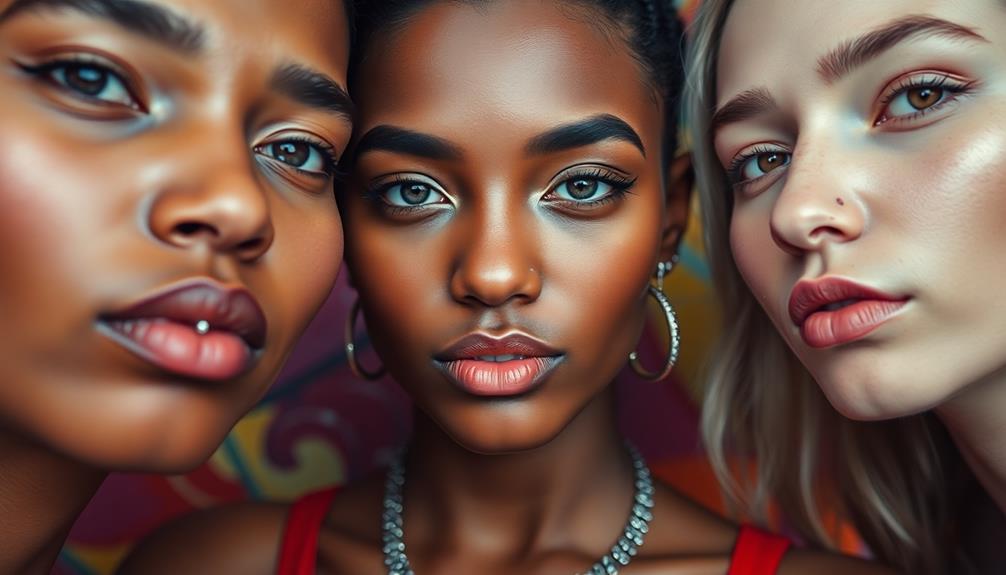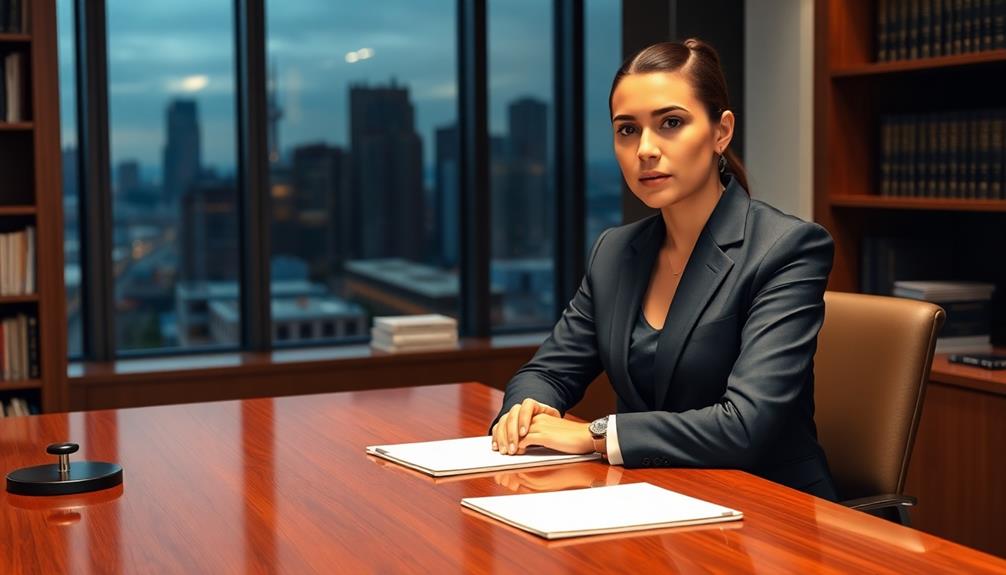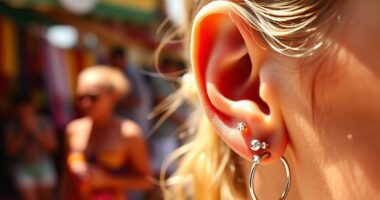Dating with piercings can greatly affect first impressions. You might find that people judge you based on your piercings, perceiving you as less attractive or intelligent, especially if you have multiple facial piercings. However, subtle piercings, like a nose stud, often lead to more favorable reactions. Cultural context matters too—urban areas may embrace your style, while conservative regions might not. Being aware of these biases can help you navigate dating effectively. Understanding how piercings influence perceptions can enhance your dating experience, leading to more meaningful connections and positive impressions in various environments. There's so much more to explore on this topic.
Key Takeaways
- First impressions are crucial; individuals with piercings are often judged more harshly regarding attractiveness and intelligence, especially in conservative settings.
- Multiple piercings lead to stronger negative perceptions, while subtle piercings, like nose studs, have milder effects on attractiveness ratings.
- Gender differences exist; males with piercings face more negative judgments than females, who often receive more favorable ratings.
- Cultural acceptance varies; urban areas tend to embrace piercings, while conservative regions may associate them with negative stereotypes.
- Piercings can signify creativity and individuality, potentially attracting partners in supportive environments where acceptance enhances attractiveness.
Impact of First Impressions

Forming first impressions happens quickly, often within just a few seconds of meeting someone. You mightn't realize it, but those initial moments can greatly impact your dating opportunities, especially if you have visible piercings.
Studies show that people often judge individuals with piercings as less attractive and intelligent during these brief encounters. This can be particularly true if you sport multiple facial piercings, which can lead to strong negative perceptions right off the bat.
Understanding how first impressions work is essential in maneuvering the dating scene. If you're aware that some may perceive your piercings negatively, you can strategize your approach.
For instance, consider the setting—urban environments tend to be more accepting of piercings than conservative areas. This knowledge can help you choose the right places to meet potential partners and feel more confident in your appearance.
Ultimately, while piercings can be a form of self-expression, they can also influence how others perceive your attractiveness and intelligence. By recognizing these biases, you can effectively manage first impressions and make the most of your dating experiences.
Cultural Perspectives on Piercings

Cultural perspectives on piercings can vary widely, with acceptance often hinging on geographic and social contexts. In urban areas like Austin and Portland, body piercings are often embraced, while conservative regions might see them as unfavorable. Understanding these cultural norms can be essential for you as you navigate dating and social interactions.
Here's a quick overview of how different cultures view piercings:
| Region | Acceptance Level | Impact on First Impressions |
|---|---|---|
| Urban Areas | High | Often seen as trendy or expressive |
| Conservative | Low | Can lead to negative stereotypes |
| Western Societies | Moderate | May evoke rebellious or "bad boy" images |
| Spiritual Cultures | Variable | Seen as meaningful and traditional |
| Professional Settings | Low | May hinder job prospects |
Your body piercings can greatly influence first impressions, especially in professional contexts. Some employers may associate visible piercings with a lack of professionalism, so it's wise to reflect on the setting before showcasing your unique style. Understanding these cultural perspectives helps you navigate varying expectations effectively.
Perceptions of Attractiveness

When it comes to perceptions of attractiveness, piercings can create a mixed bag of reactions. Research shows that individuals with facial piercings often face biases, especially from male evaluators who tend to rate pierced men as less attractive than their non-pierced counterparts.
Multiple piercings, in particular, can lead to the lowest attractiveness ratings, while subtle options like nose piercings typically have a milder effect on first impressions.
Cultural context plays an essential role in how piercings are perceived. In urban areas, people may be more accepting of piercings, which can positively affect your dating prospects. However, stereotypes often link piercings to non-conformity and risk-taking behavior, which can sway initial attraction.
It's important to note that open-minded individuals are less likely to hold biases against those with piercings, suggesting that personal attitudes greatly shape perceptions of attractiveness.
If you're steering through the dating scene with piercings, be aware that your unique style may elicit a variety of reactions, but it can also attract those who appreciate individuality and self-expression.
Ultimately, confidence in your choices can enhance your appeal, regardless of others' perceptions.
Intelligence and Piercings

When it comes to dating, you might notice that perceptions of intelligence can vary markedly based on the number and type of piercings you have.
Research shows that men with multiple facial piercings often face harsher judgments regarding their intelligence, especially from other men.
Context plays a big role too, as certain piercings, like nose studs, seem to have a lesser impact on how intelligent you appear.
Perceptions of Intelligence Variability
Perceptions of intelligence often hinge on visible traits like piercings, revealing how biases can shape our judgments. If you have facial piercings, you might find that first impressions can be greatly affected.
Studies indicate that males with facial piercings are often perceived as less intelligent, a view held by both male and female assessors. When multiple piercings are present, the negative bias intensifies, leading to lower ratings for both attractiveness and perceived intelligence.
Notably, not all piercings carry the same weight in these assessments, and understanding the implications of trust creation net worth thresholds can provide insights into how financial status may also influence perceptions. Nose piercings, for example, tend to have the least detrimental impact on how others view your intellect. This suggests that while some styles are more accepted, others can trigger harsh judgments.
Your personal context also plays a role; open-minded individuals generally exhibit reduced bias against piercings, indicating that attitudes can influence perceptions of intelligence.
Additionally, cultural factors considerably shape these judgments, especially in Western societies where facial piercings are often viewed unfavorably. Understanding these dynamics can help you navigate the dating scene more effectively, allowing you to present your true self without the cloud of misjudgment.
Gender Differences in Judgments
Research reveals significant gender differences in how piercings affect judgments of intelligence and attractiveness. Studies show that facial piercings affect perceptions differently for men and women. Males with facial piercings are often rated less attractive and less intelligent by both genders, while females with piercings tend to receive more favorable ratings. This discrepancy highlights the bias in how we assess attractiveness based on gender.
| Gender | Perception of Attractiveness | Perception of Intelligence |
|---|---|---|
| Males | Lower with piercings | Lower with piercings |
| Females | Higher with piercings | Similar with piercings |
| Nose Piercings | Least negative effect | Least negative effect |
Research indicates that multiple piercings correlate with decreased attractiveness and intelligence ratings for both genders, with men facing a more pronounced negative impact. Notably, nose piercings are seen as having the least detrimental effect. The psychology of first impressions plays an essential role here, as open-minded individuals often display less bias against piercings, reflecting how personal attitudes shape these gender differences in judgments.
Contextual Influence on Perception
In various social settings, the impact of piercings on perceptions of intelligence can vary widely. Research shows that individuals with facial piercings, especially men, are often viewed as less intelligent. This bias can considerably affect your first impressions in dating scenarios.
For instance, studies indicate that males with multiple piercings tend to receive lower ratings in both attractiveness and intelligence from evaluators. Such perceptions can detract from your dating opportunities, especially in conservative contexts where facial piercings elicit stronger negative judgments.
However, context plays an essential role. While some may perceive piercings as a sign of lower intelligence, others may overlook them, especially if the piercings are subtle. Open-minded individuals often display reduced bias against body modifications, suggesting that personal attitudes can shape how piercings influence perceptions of intelligence.
When you're maneuvering the dating scene, consider the setting and the attitudes of those around you; they can greatly affect how your piercings are perceived. Ultimately, understanding these contextual influences can help you manage first impressions and guide your dating life more effectively.
Dating Scenarios and Reactions

When you're maneuvering the dating scene, your piercings can spark a range of reactions from potential partners. While some might find them trendy and expressive, others may perceive you as less attractive or intelligent, especially in a conservative setting. A 2012 study showed that individuals with visible piercings often receive lower attractiveness ratings, particularly among male evaluators. This can greatly impact your first impressions during dates.
Interestingly, the number of piercings plays an essential role in how you're perceived. Multiple piercings tend to lead to negative reactions, while some find women with facial piercings to be more creative, enhancing their dating appeal.
Reactions can vary widely; some view pierced individuals as rebellious or non-conformist, which might attract adventurous types, while others might see them as risky or unapproachable.
Cultural acceptance of piercings also influences these impressions. In urban areas, piercings may be embraced, allowing for easier connections, while more conservative environments can stifle opportunities.
Understanding these dynamics can help you navigate the dating landscape with greater awareness of how your piercings affect first impressions.
Personal Expression and Identity

Your piercings can serve as a powerful means of personal expression, showcasing your individuality and unique style. When you choose to adorn your body with piercings, you influence how others perceive your personal appearance. Many people make snap judgments based on visual cues, and your piercings can positively affect first impressions in dating scenarios.
They often signal creativity and open-mindedness, traits that attract potential partners looking for someone who embodies these qualities. Facial piercings, in particular, convey a laid-back and trendy image, appealing to those who value non-conformity and self-expression.
In more accepting environments, having piercings can enhance your attractiveness, as they reflect a willingness to embrace personal identity. Your motivations for getting piercings, whether for fashion enhancement or cultural significance, contribute to the narrative you present on dating platforms.
These choices can lead to deeper connections with those who appreciate your distinct style and values. Ultimately, your piercings are more than just adornments; they tell a story about who you are, shaping the way others see you in the dating world.
Professional Considerations

Maneuvering the dating scene with visible piercings requires careful consideration of professional image and societal perceptions. In conservative industries, piercings can lead to negative judgments about your professionalism.
Studies show that men with visible piercings often receive lower ratings in attractiveness and intelligence, which can hinder dating prospects in professional environments.
To make a positive first impression, it's wise to adopt a strategic approach to your appearance. For example, dressing more formally or temporarily removing piercings during interviews can help counteract biases associated with body modifications.
This awareness extends beyond just dating; your appearance can influence career advancement and professional relationships, too.
Cultural context also plays an essential role; urban settings tend to be more accepting of piercings, while rural or conservative areas may not be as welcoming.
Understanding the workplace culture around piercings can help you navigate both your professional life and dating scene more effectively.
Navigating Social Biases

When you have piercings, social perceptions can create challenges in dating.
Depending on where you are, cultural acceptance might vary widely, affecting how others view you.
Social Perception Challenges
Many individuals with piercings encounter significant social perception challenges in the dating world. The biases surrounding piercings can heavily influence first impressions and overall attractiveness. Research shows that men with facial piercings are often viewed as less attractive and less intelligent than their non-pierced peers. Unfortunately, the number and visibility of piercings can further exacerbate these biases.
Consider these factors that shape social perception:
- Cultural Context: Urban areas may be more accepting of piercings, while conservative regions might react negatively.
- Stereotypes: Many people associate piercings with risk-taking behavior or non-conformity, leading to snap judgments.
- Attractiveness Ratings: Studies indicate that individuals with multiple piercings receive the lowest attractiveness ratings.
Navigating these challenges requires awareness of how societal biases can impact your dating experience. Understanding that first impressions are often influenced by preconceived notions about piercings can help you approach potential partners with greater confidence.
While piercings can be a form of self-expression, they may also present hurdles in creating lasting connections in the dating scene.
Cultural Acceptance Variances
Maneuvering the dating landscape with piercings means understanding the cultural acceptance variances that exist across different regions. In urban areas like Austin and Portland, you'll find a more open-minded approach towards piercings, which can enhance your dating experiences.
However, in conservative regions, visible piercings mightn't be as welcomed and could even impact your first impressions negatively. Awareness of local cultural attitudes is vital.
In traditional workplaces, for instance, piercings can diminish your job prospects, creating a ripple effect in your dating life. Your social circle also plays a role; individuals in fashion-forward or alternative communities often embrace body modifications, while traditional groups may harbor biases that affect their perceptions.
As societal norms evolve, there's a slow shift toward greater acceptance of piercings, but the stereotypes linked to them persist. You need to navigate these cultural landscapes with care, as your piercings may shape how others perceive you.
Ultimately, being mindful of cultural acceptance can help you make informed choices and create more positive first impressions in your dating journey.
Overcoming Stereotypes Together
Here are some strategies to overcome stereotypes together:
– Educate and Communicate: Share your passion for piercings, explaining what they mean to you. This helps shift focus from appearance to personality.
By embracing an abundance mindset, you can cultivate a positive self-image that defies societal judgments.
- Seek Like-Minded Connections: Surround yourself with individuals who appreciate body modifications. This supportive environment can help mitigate negative stereotypes.
- Be Mindful of First Impressions: Dress and accessorize in ways that reflect your personality while considering your dating context, especially in more conservative areas.
Frequently Asked Questions
How Are People With Piercings Perceived?
People with piercings often evoke mixed perceptions. Some view you as trendy and rebellious, while others might associate you with negative stereotypes. Ultimately, individual biases and cultural contexts shape how people perceive your piercings.
What Does Psychology Say About Piercings?
Ever wonder how society views piercings? Psychology reveals that they often influence perceptions, suggesting you might be seen as creative yet potentially less serious. Your unique style can spark intrigue, but biases may linger in others' minds.
What Do Piercings Symbolize?
Piercings symbolize individuality and self-expression. They reflect your personal style and creativity. Depending on cultural context, they can convey rebellion or trendiness, impacting how others perceive you and your willingness to embrace uniqueness.
Do Piercings Look Unprofessional?
Like a double-edged sword, piercings can look unprofessional in certain settings. If you're in a conservative workplace, you might want to contemplate removing them or dressing more formally to avoid negative perceptions.
Conclusion
In the end, don't let preconceived notions about piercings dictate your dating experience. While some might argue that piercings can be off-putting, they actually serve as a powerful form of self-expression. Embracing your unique style can attract like-minded individuals who appreciate you for who you truly are. So, whether you have one piercing or a whole collection, remember that confidence is key. Ultimately, it's about finding someone who values your individuality, not just your appearance.
















